The Toyota Glanza is essentially a rebadged Maruti Suzuki Baleno. Why has Toyota resorted to this badge engineering strategy? The simple answer is – the Japanese automaker is leveraging its global partnership with Suzuki to share models and technologies, to establish its presence in the premium hatchback segment with the Baleno-based Glanza, and the compact SUV segment with Brezza-based Urban Cruiser. Not only do these relatively more affordable models (than the Innova Crysta and Fortuner) open up Toyota’s doors to a wider set of customers, they also increase overall sales volumes. And besides boosting profitability for both the company and its dealers, these models also help the company achieve Corporate Average Fuel Economy (CAFE) targets.

Earlier this year, the Maruti Suzuki Baleno underwent a major transformation, and now, its Toyota equivalent follows suit. Like the Maruti, the Glanza gets a new petrol engine, an automated manual transmission (AMT), which replaces its CVT (automatic), gets some structural enhancements, completely new interiors and a laundry list of equipment.
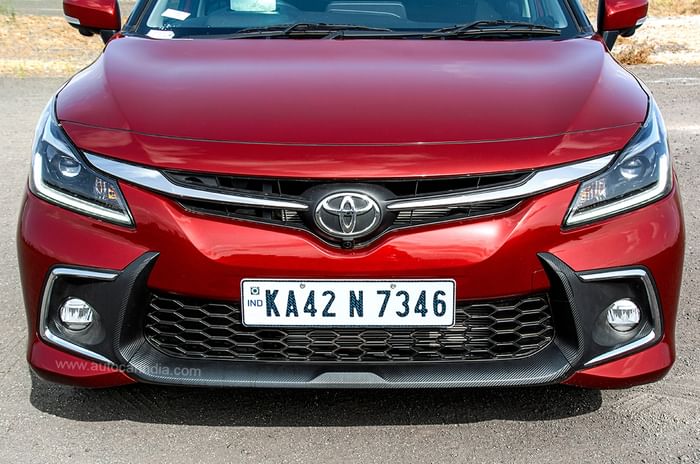
For the 2022 iteration, Toyota designers have gone to greater lengths to establish family ties with its Toyota stable mates, unlike the 2019 iteration which looked identical to its Maruti twin. Its new striking headlamps feature L-shaped LED Daytime Running Lamps and are connected by a nicely stretched chrome band, which not only visually enhances the car’s width, but it appears to be lifted off the Camry Hybrid sedan. A distinctive bull-horn design element around the front air dam looks rather radical and it is finished in a carbon fibre design to add a sporty touch, while C-shaped chrome touches add some bling. The only other Toyota-specific change is its new 16-inch diamond-cut alloys. Side and rear profiles, however, remain identical to the Baleno.

This facelifted version is shorter by 5mm in length and 10mm in height, although its width and wheelbase haven’t been altered. The bigger news here is that this iteration underwent certain structural enhancements and also gets some new equipment, on account of which the base variant is 10kg heavier than a corresponding pre-facelift variant, while the top manual variant is 65kg heavier, tipping the scales at 955kg. The AMT variant is 25kg heavier than the outgoing CVT.
2022 Toyota Glanza: interior
 Interiors are a big step up in terms of design, quality and appeal. Beige and black feel bright and lend an upmarket feel.
Interiors are a big step up in terms of design, quality and appeal. Beige and black feel bright and lend an upmarket feel.
The interiors have been significantly revamped and it now gets an all-new dashboard and several other bits, which have gone a long way in upping the Glanza’s desirability quotient. Toyota’s very premium-looking beige-black theme makes a great first impression, and brightens up the cabin. The use of piano black and silver highlights, along with upmarket bits like a flat-bottomed steering, an entirely new climate control console and a new free-standing touchscreen further lift its appeal.
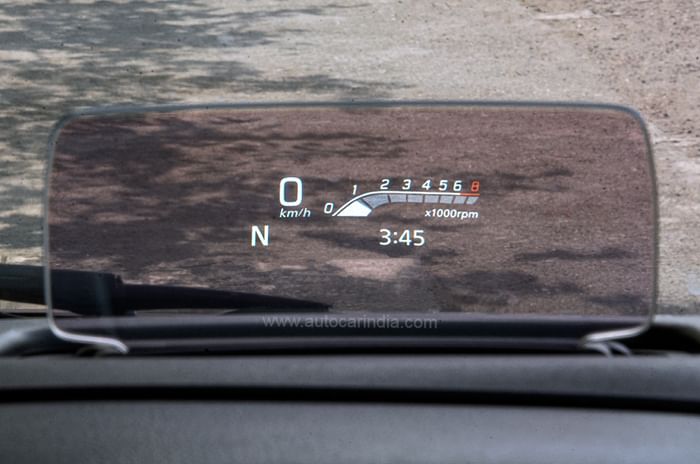 Head-up display is a cool party trick.
Head-up display is a cool party trick.Taking centre stage is the all-new 9-inch touchscreen infotainment system. It is feature packed with Android Auto, Apple CarPlay, voice commands and connected car tech via an app. Further, it packs in a premium sound system that’s tuned by Arkamys. Even though it has all the right ingredients on paper, its execution isn’t perfect – its high placement hampers frontal visibility; the screen is a bit too reflective especially under the afternoon sun; and rivals like the Tata Altroz and Hyundai i20 offer a punchier and crisper sound output.
 Soft seat cushioning isn’t ideal for long journeys.
Soft seat cushioning isn’t ideal for long journeys.
Ergonomics, as before, are spot on and finding the right driving position is very easy thanks to a tilt and telescopic steering as well as a plethora of seat adjustments. The seat cushioning, however, is too soft for comfort, which could trigger back and/or muscle aches over long drives.
 Headroom for taller passengers is limited, although legroom is aplenty.
Headroom for taller passengers is limited, although legroom is aplenty.
Rear seat space is adequate, but tall passengers will find their heads brushing against the roof. The Glanza’s seat isn’t as wide as the i20’s to accommodate three abreast in reasonable comfort. This Toyota finally gets dedicated AC vents and nifty charging provisions for rear occupants. Curiously, luggage space has gone down from 339 litres to 318 litres, and its high-set tall boot lip isn’t very convenient to load and unload heavy luggage.
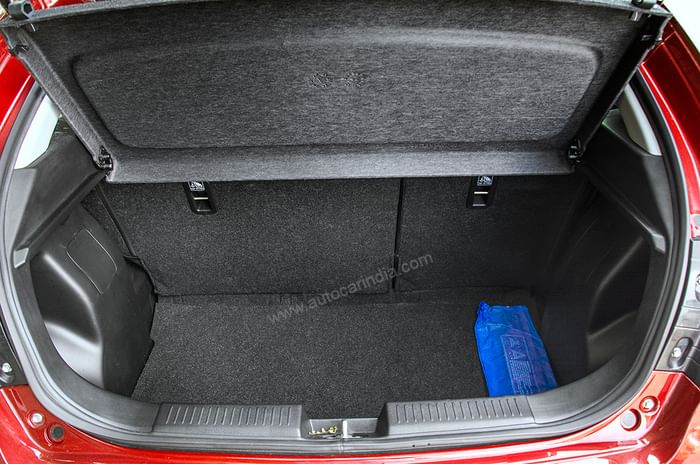 High loading lip isn’t very convenient.
High loading lip isn’t very convenient.The Glanza gets an extremely useful 360-degree camera, which is handy while parking in and out of tight spots. Toyota also offers a retractable heads-up display, which pops out from the dash. It’s a great party trick, but the speed projection isn’t in the driver’s natural field of vision, and hence, some might prefer leaving it tucked away. Toyota has also taken steps in the right direction by equipping the Glanza with new safety kit such as ESP, hill-start assist and six airbags. However, in-vogue features like a sunroof, wireless charging and wireless Android Auto/Apple CarPlay have been given a miss.
 Finally gets rear AC vents, USB charging.
Finally gets rear AC vents, USB charging.2022 Toyota Glanza: engine and fuel efficiency
Replacing the pre-facelift Glanza’s petrol engines (K12B and K12C) is an all-new 1.2-litre K12N naturally aspirated petrol unit which makes 90hp and 113Nm. In Toyota’s quest to improve fuel efficiency and keep a check on emissions, this new engine also gets engine stop-start. Further, the company has dropped the CVT (automatic) option and replaced it with a 5-speed AMT, which improves fuel efficiency by 17 percent from 19.56kpl (K12B engine with CVT) to 22.94kpl (AMT). The other transmission option being a 5-speed manual with a claimed fuel efficiency of 22.35kpl, which is more than the K12B’s 21.01kpl, but lesser than the K12C’s 23.87kpl.
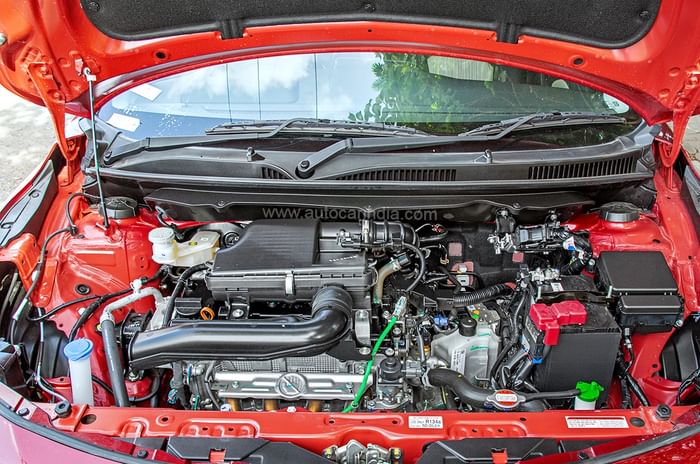
Like its predecessor, this four-cylinder engine is one of the best in its class in terms of refinement and smoothness. It feels adequately peppy to potter around town in a quiet, vibe-free manner. If you have experienced the older-gen K12B, performance will feel a tad dispirited in its current guise; it doesn’t pull as strongly nor does it spin as freely as it once did. When you wring this motor, it’ll still entertain you with a second wind beyond 4,500rpm emitting a sporty growl, although the build-up of speed isn’t particularly rapid. Its five-speed manual gearbox is the smoothest in its segment, and paired to an extremely light hydraulic clutch, it makes rowing through the gates an absolute breeze.
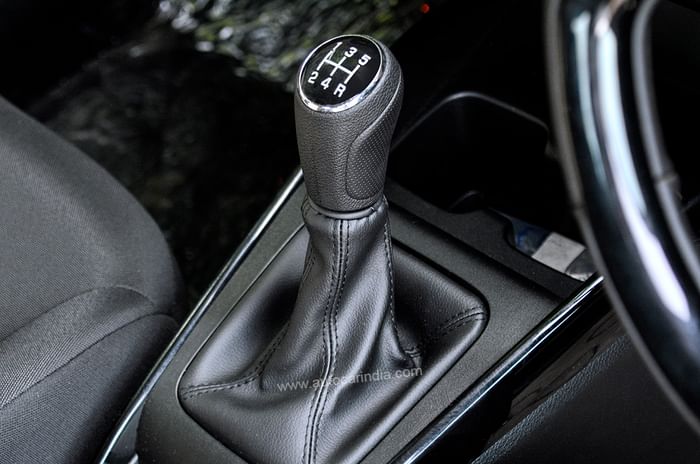
As delightful as the manual is, Toyota’s choice of opting for a 5-speed AMT in this segment seems like a step in the wrong direction, especially when its rivals offer more advanced and smoother dual-clutch and CVT automatic offerings. The AMT is programmed to reach the highest possible gear at the earliest in the interest of efficiency, and with gentle accelerator inputs and light traffic, it does a reasonable job with negligible ‘head nod’ between shifts. However, amidst denser traffic, where maintaining constant speeds isn’t possible, the AMT pauses and hunts for the correct gear, which gets quite annoying.
But this Toyota proves its mettle in an area which matters to buyers – fuel efficiency. In our tests, the manual returned 13.80kpl and 17.50kpl, while the AMT returned 11.86kpl and 17.21kpl, in city and highway conditions, respectively. What’s interesting is that unlike most automatic engine-stop-start systems, it doesn’t switch on the engine automatically (while idling) if the cabin temperatures rise higher than the preset climate control temperatures; it will only do so when you depress the clutch pedal in the manual or ease off the brake pedal in the AMT.
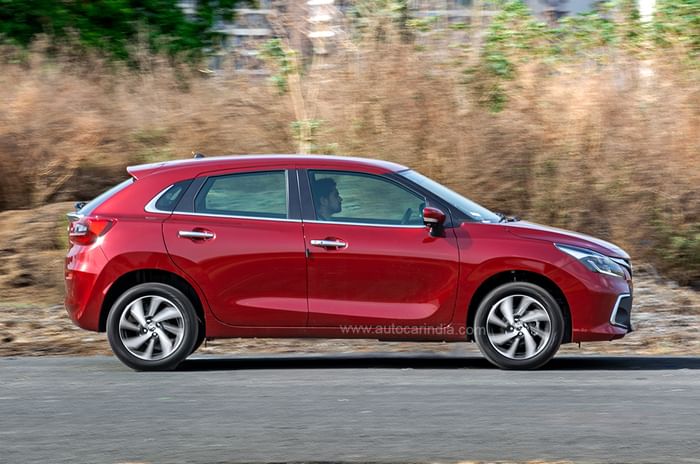
The Glanza’s suspension has been reworked, and as a result, its low speed ride is one of the nicest in its class, absorbing potholes and road imperfections in a very mature manner. At highway speeds, however, its ride doesn’t feel quite as plush and it transmits road shocks rather sharply into the cabin resulting in a busy ride. The steering also witnesses a huge improvement over the earlier iteration – it feels more fluid, remains reasonably light and it also returns to centre (after a U-turn) in a rather natural manner.
2022 Toyota Glanza: price and verdict
If you’re looking for a convenient automatic hatchback, the Glanza AMT doesn’t quite make the cut, as this transmission isn’t quite as smooth or sorted as the CVT it replaces. Also, if your usage includes a significant amount of highway driving, its overtly soft seats and its busy ride at higher speeds, don’t make it ideal for long-distance cruising. But wearing an attractive price tag of Rs 6.53 lakh-9.91 lakh, it is really hard to overlook what the Glanza brings to the table. With this mid-life update, Toyota has taken several steps in the right direction by enhancing its design and interiors, and offering a generous equipment list. Its new petrol engine is quite simply among the best in class in terms of smoothness and refinement, the manual is effortless to drive, and more importantly, it is incredibly fuel efficient, which is one of this Toyota’s key highlights. Toyota’s strong brand equity and the peace of mind associated with the ‘T’ badge further strengthen its case.







































